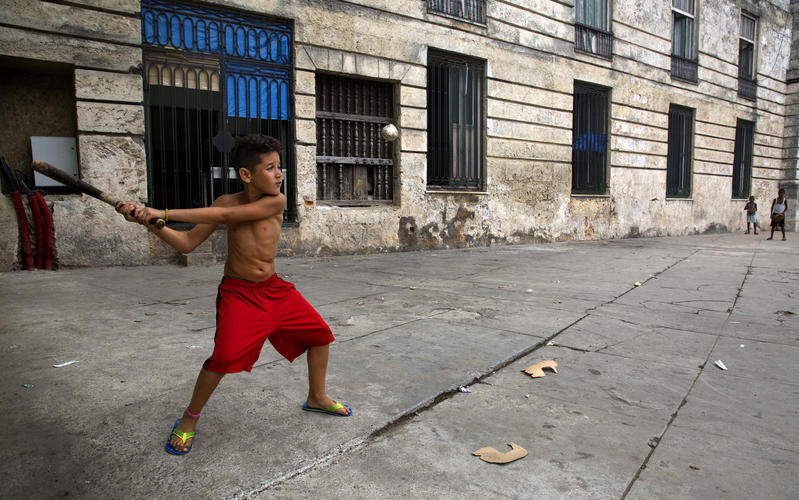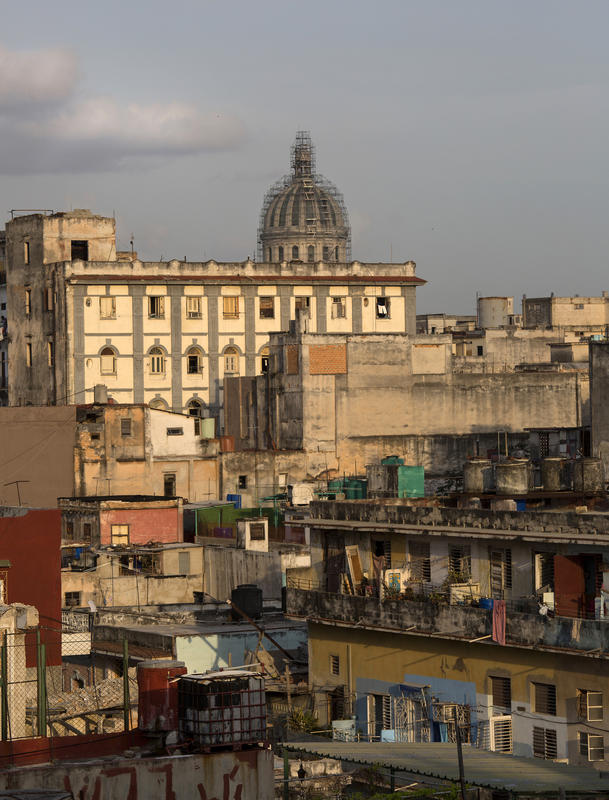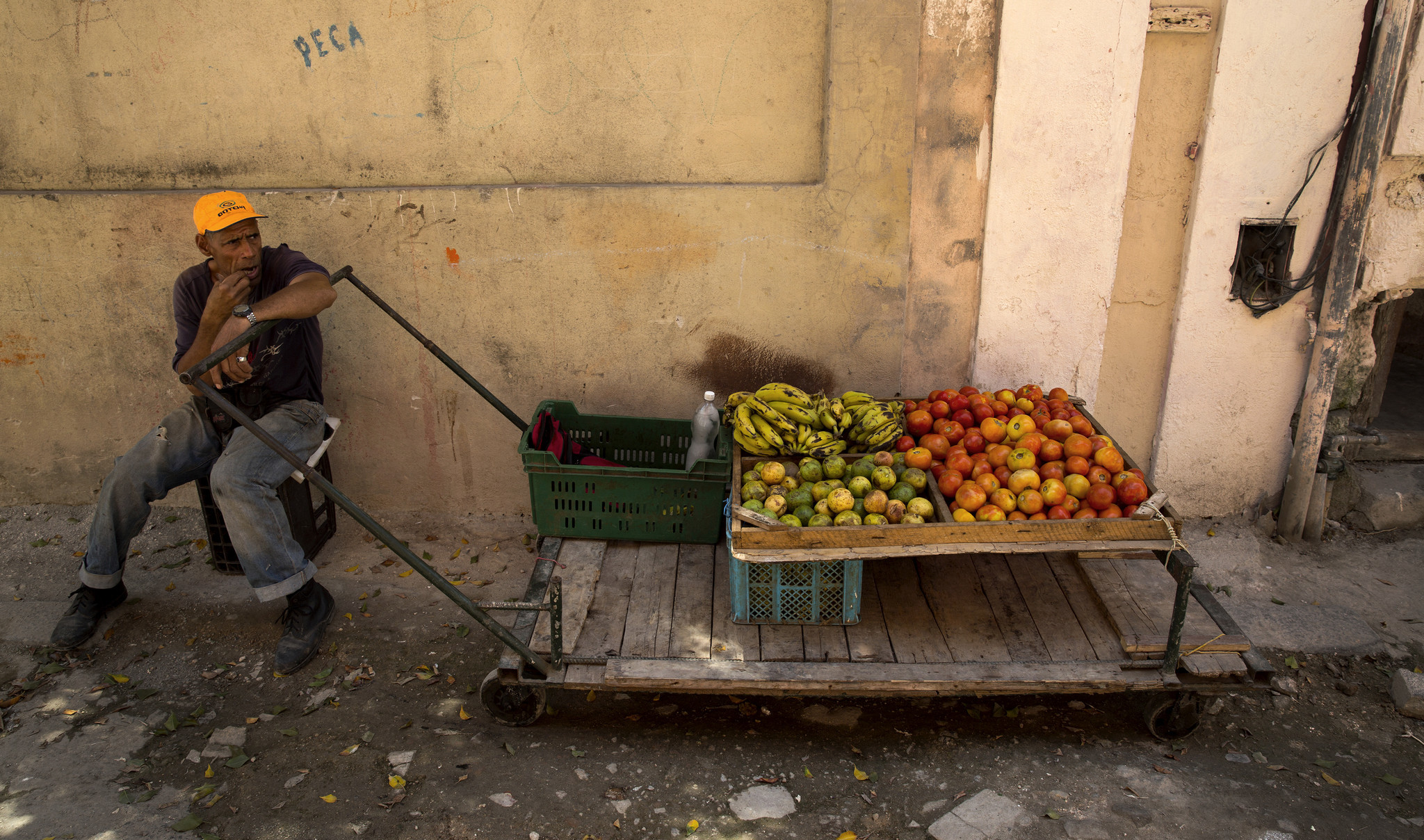On her fifth visit, an American marvels anew at the juxtaposition of sophistication and scarcity. Everyday Cubans share emotions freely but still whisper certain topics.
I was hunting for potatoes. People said there weren’t any in the markets this winter, and I hadn't seen any either, not even as French fries on tourist menus.
But that morning, my host had said that a potato shipment was arriving in our part of Old Havana, and if I wanted to understand day-to-day life in Cuba, I needed to see the line of people waiting for them.
I’ve been to Cuba five times in the last 15 years — each time legally, because journalists are allowed to go — and I’m still trying to understand it.
So now I was walking down Calle Habana — in the street itself, the way locals do — dodging people and jingling pedicabs and the occasional automobile. And thinking how Third World these backstreets felt.
Except Cuba isn’t the Third World. That contradiction is part of what draws me back.
Cuba has universal healthcare, a literacy rate higher than the United States — 99.8% to our 99% — and a lower rate of infant mortality. Plus magnificent colonial architecture, gorgeous beaches and a sophisticated arts scene that includes good museums and world-class ballet.
The catch is living conditions. “Ninety percent of the people don’t live good,” a retiree told me. “Fifty-six years, and it’s more bad every year.” The problem isn’t politics, he said; it’s economics.
Because money is scarce, Havana’s neighborhoods tend to be shabby and overcrowded, none more than my favorite: Habana Vieja — Old Havana — the historic heart of this nearly 500-year-old city.



Its three main plazas are exquisitely restored, creating a magnet for visitors as well as citizens. But if you walk a street or two off any of these showpieces, you’re in a tropical version of the South Bronx: crumbling facades, broken steps, dingy entryways and unlighted stairwells, electrical wires hanging in hanks and broken sidewalks like the ones I was trying not to stumble over along Habana Street.
It’s all picturesque, but it feels sinister — even though, amazingly, it isn’t.
People talk to you on these backstreets. People smile. People lean out of doors and windows to chat, joke, ask where you're from and raise an eyebrow if you say “Estados Unidos” because they know — far better than most Americans do — that we are still prohibited by U.S. law from traveling to Cuba as freely as we can almost anywhere else. As one Cuban woman put it, “Our Berlin Wall is the Caribbean Sea.”
I hadn’t planned on leaping that wall this winter, but then came President Obama’s December announcement about normalizing diplomatic relations, and I changed my mind.
Cuba gets about 3 million tourists a year — a third of them from Canada — but nobody knows whether the country can handle the inundation of Yankees who will come as soon as the United States allows it. I wanted to see Cuba one more time before all that begins.
Wherever I went, I talked to people (in Spanish, thanks to years of lessons).
I said hola to the women sitting in doorways, admired pet dogs (Pekingese blends are big in Havana), questioned taxi drivers and museum guards, chatted up guys selling fruit and vegetables from wooden carts, and joked with the purveyors of old books, Che Guevara caps, revolutionary medals and cheap Russian cameras at the stalls around the Plaza de Armas.
Sometimes I got answers before I even asked.
“Three of every five Cubans have been to university,” a young guy in shorts and a tank top, leaning against a wall in my neighborhood, announced one morning. He held up his fingers for emphasis: “Three out of five! But we don't have freedom of expression.”

People still lowered their voices when they complained about the government.
But I saw less propaganda this time — just an occasional image of Fidel Castro or Che or a “Socialism forever” slogan on a wall — and one sweet billboard: It showed a little black girl proudly clutching a schoolbook and smiling. “Her dreams of emancipation,” the text read, “have come true.”
Material abundance has not, which explains why many Cubans carry a shopping bag whenever they go out.
You have to be ready, one woman explained: “You never know when you’ll run across something you might need or something you could sell.” That’s exactly what people did in Eastern Europe before the Iron Curtain dissolved.
This constant foraging creates storage problems for people with small apartments, which is almost everybody. One couple I stayed with this winter stockpiles everything from toilet paper to fluorescent light bulbs under their bed. They call it their bodega — their warehouse.
“We say we even keep our coffins under there,” the husband said, joking.
But enough has changed since 2009, when I last visited, that Cuba felt more “normal” to me this time — that is, less socialist.
In just the last four years, for example, Cubans have been granted freedoms that Americans have long taken for granted: The right to buy and sell their houses and cars. The right to travel outside Cuba, the way tourists from other countries do. The right to start their own small businesses.
These include tourist rentals in private homes. They’re everywhere now. In Old Havana this winter, the going rate was 25 to 30 euros, or about $27 to $33 a night, vastly below what big hotels charge. But the real bargain isn’t the price; it’s that you get to spend time with ordinary Cubans.
And eat with them, watch fuzzy TV with them, kid around with them. You really do get treated like one of the family.
One hostess spent an entire evening showing me her family album, snapshot by black-and-white snapshot. Each was a glimpse of middle-class Cuban life before the punishing combination of the 1959 revolution and el bloqueo — the American trade embargo that followed.
For people like her, who were children in 1959, this reminiscing triggers deep nostalgia, sometimes tears. Even small things can touch it off.
One day I went to Coppelia, the famous open-air ice-cream parlor that fills a city block in the more modern neighborhood of Vedado. “What did you have?” my host asked later. “Strawberry or vanilla?” Both, I said.
“That’s all they ever have,” he said. “Oh, before the revolution we used to have so many flavors. Mango, papaya, pineapple, banana, avocado ... .”
Weren’t there any good times after the revolution? I kept asking.
Oh, yes, people invariably said: “When the Russians were here.”
“There was enough food,” one woman recalled dreamily. “There were clothes. Not good clothes, but clothes. And you couldn’t travel anywhere. But the money the government gave was enough then — not enough to live in luxury, but enough to live.”
That ended in the early 1990s, when the Soviet Union collapsed. The Russians had been buying nearly all of Cuba’s sugar crop, its economic mainstay, and without another market, Cuba collapsed too.
People nearly starved. There was malnutrition, and the country's average body weight declined. Some city dwellers even took to raising food in their apartments — usually just chickens and eggs, though some people raised pigs in their bathtubs.
“Some still do,” a woman in my neighborhood confided. “And the smell!”
What put the Cuban economy back on its still-uneven feet was tourism. The government sought foreign investments — not from the U.S., of course — to build big hotels on Varadero Beach east of Havana. And it continued restoring the best of the decrepit buildings in Old Havana. Now even history generates revenue for the government.
It’s not enough. Foodstuffs, for example, remain rationed. Each month, the government provides Cubans with staples — rice, beans, coffee, eggs, cooking oil and frozen chicken — not a complete diet, just support. But the distribution system for these basics is so complicated that it took my hosts almost an hour to explain it to me.

“Does everybody get this food?” I finally asked. “Even the rich?”
“No! No!” my host said, in mock shock. “We have no rich. We have only intellectual class and worker class.”
He gave me the hint of a smile. Everybody knows that isn’t true anymore.
With free enterprise seeping in, another homeowner said, “There are starting to be” — and she paused — “inequalities.”
And just about everybody on the backstreets is trying to even those out.
Some people sell stuff out of their windows — fruit juice, coffee, even cheap rum — the adult equivalent of a kid’s lemonade stand at home.
Others go into business on the spot. “You need a place to stay?” an elderly man called to me in the street one morning. “I can get you one for 20. OK, 15.”
So far, private enterprise hasn’t led to more ice cream flavors, let alone more potatoes.
My host turned out to be wrong. The potato shipment had come in the day before, and the supply ran out before the line of waiting people did. I never got to see them, but he was right: They did help me understand Cuban reality. So did my host’s frustration.
“To live like this for 56 years!” he burst out. “Without electricity sometimes, without new clothes, without foods, without getting or sending letters to people outside, without phoning outside, without belonging to any religion.”
He struggled for composure. “It is a sad history,” he finally said. “But we are alive.”
Captions:
Top: Dancers in the Plaza de Armas in Old Havana.
Bottom: A produce vendor waits for customers in an Old Havana alleyway.










Share your experience
Share your experience in Cuba with us on Twitter and Instagram using the hashtag #LATCuba